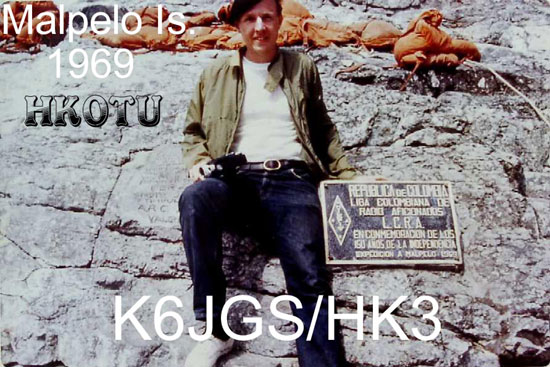

The author of this report is Don Blankenship, K6JGS/HK3 who today is W4PUL. Don was the 8mm video photographer for the expedition and produced an hour long movie of the event.
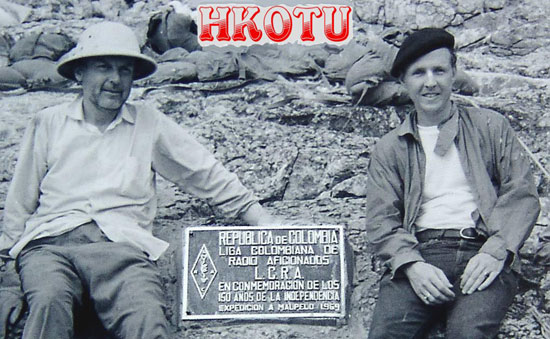
Bob Denniston W0DX left and Don
Blankenship K6JGS/HK3 (now W4PUL) (right) the plaque reads:
RADIO CLUB OF COLOMBIA
In celebration of 150 years of Independence
1969 Expedition to Malpelo
The Bronze plaque was placed on Malpelo by the LCRA (Liga Colombiana de Radioaficionados). It commemorate 150 years of independence of ownership of this island by Colombia. During the time the radio amateurs operated on the island, the president of Colombia spoke with the hams who participated in this DXpedition. The Colombian Air Force flew the amateur radio equipment from Miami to Colombia. The Colombian navy provided the transportation to the island and also aided in the material support and rescue of the injured expedioners who were seriously injured while trying to land on Malpelo. The U.S. embassy in Bogotá provided equipment support. USAID provided the sleeping gear, canvases for shelter, etc. The U.S. Army in the Canal Zone provided K-rations for the expedition group. The U.S; Defense Attaché Office at the U.S. Embassy in Bogotá provided coordination and support for the operations as well. Drake Electronics provided discounted amateur radio equipment for the expedition. Hy-Gain provided two 3-element beams. And Bob Denniston, the president of the ARRL provided his own kite which served to hoist the 160 meter antenna wire up onto the rocks and made for the first 160 meter contacts ever from Malpelo.
The first thing to remember about the 1969 DXpedition to Malpelo is that it was a Colombian effort to commemorate 150 years of independence. The purpose was to reaffirm Colombian sovereignty over Malpelo Island. The non-Colombians on the expedition were simply invited guests who helped facility the expedition. During the expedition, the president of Colombia spoke to the radio amateurs and expressed his appreciation for the recognition they'd provided in this commemorative effort. The flag of Colombia was raised on the island and left there when the expedition group departed.
Expedition members assembled at the home of Jose Saouda HK5BFJ in Cali, Colombia in February 1969 just before the launch of the DXpedition to Malpelo.
It should be noted that the man standing 3rd from the left is Jose Saouda HK5BFJ, at the time was the Cali regional director of the Colombia Amateur Radio League. He was the hero who jumped into the ocean to save the life of the president of the Colombian league, Bill Elasmar HK3RQ (bald man in the center). Bill, who was hit by a huge ocean wave, fell off the rock face of Malpelo and back into the ocean and was then crushed by a 900 lb. balsa raft. He was knocked unconscious and floating in the ocean in a pool of blood. Jose Saouda dove off from the LCVP landing craft into the ocean knowing full well that he might easily be attacked by sharks. He managed to throw a line around Bill's limp body who later was hoisted aboard the LCVP with broken legs, a fractured arm, and several broken ribs. Large pieces of flesh had been gouged out of his arms and legs when he fell off the island. It was an unfortunate incident and not associated with Bill's age. Bill noted for the group prior to the expedition that he had gotten himself into very good physical shape during the year before the expedition began. So there actually was a real life hero during this expedition. Gabriel Becerra HK3HY also was swept into the ocean by the same wave. Gabriel was an attorney in Bogota as I recall. He was rather quiet and I believe I only spoke with him once but never got to know him. He never actually made it onto the island because of the large wave. He also had lacerations of his arms and legs. So the story I heard was that he also went to the hospital in Cali, Colombia. However, the ship's doctor on the destroyer, Almirante Padilla, may have cleaned and stitched up his wounds sufficiently that he could depart from the ship for home after it arrived in Buenaventura, Colombia. I just don't know for sure because I never saw him again.
It is interesting to note that Jose Saouda had in his possession on the LCVP an M-3 automatic rifle especially for shooting sharks that might appear during the landing operations. The author of this report carried on his hip a Colt Python .357 magnum with a 6" barrel for whatever contingencies. Fortunately no sharks were in the immediate area when the accident occurred when the two radio amateurs were very seriously injured. The video of the expedition actually shows the incident of the two men falling off the mountain at the moment it occurred.

LEFT TO RIGHT:
HK5ASF Enrique, HK5BAS Pacho, HK5BFJ Jose Saouda, HK5ACI Louis,
HK3RQ Bill Elasmar MD, W0DX Bob Denniston, W4DQS Dale Streiter,
U/I woman, K6JGS/HK3 - W4PUL Don Blankenship, HK3VA - TI2CF
Carlos Fonseca, W4VPD Enos Schera, and HK3HY Gabriel Becerra.
Photo courtesy of HK5VFJ - Jose Saouda, president of Cali
District, LCRA

The first attempts to land on Malpelo were done using a long boat with six oarsmen. The radio amateurs were put aboard a long boat which then paddled to the island only to find that the currents were much too strong. The rudder of the long boat broke off and those in the boat were left to float in the sea. An LCVP motorized landing craft had to rescue the long boat. In their attempt to approach the island they discovered that no amount of muscle power was enough to approach the island due to the strong currents.
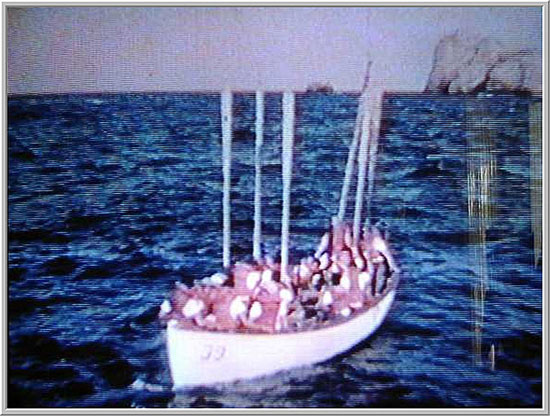
During the first day attempted landing on Malpelo it was discovered that it would be impossible to land and that a new strategy for putting people and material aboard the island would have to be devised. This cost the amateurs one full day of HK0TU radio operations. So the remainder of the day was spent fishing for tuna. However, late in the afternoon a pirate ship arrived at Malpelo with no flag. The destroyer, clearly on a military operation, suspended all activities to chase after this pirate ship. An armed boarding party pursued the ship and went aboard to check their documentation. It was found to be a rogue ship with no documentation and no permits to be near Malpelo. Warnings were issued and no shots were fired. We never learned what the purpose of this ship was doing at Malpelo but it obviously was there to fish illegally. Malpelo is a protected military zone as far as the Colombian navy was concerned. No one goes there without official approval.
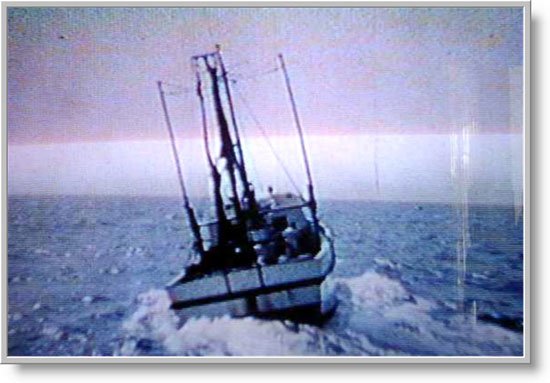
Pirate ship spotted in the area!
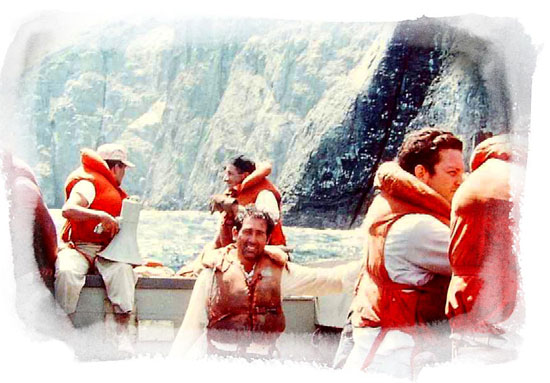
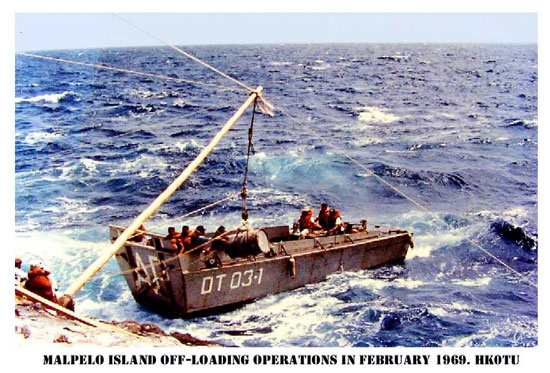
The sucessful transportation from
the Colombian destroyer was performed using a WWII era LCVP which
uses a 900 HP engine. This was the landing craft used when
marines hit the beaches on many of the Pacific islands held by
Japanese forces. Enos Schera W4VPD is seen facing the camera.
TI2CF is to his right. Enos was a marine infantryman during the
assualt on Okinawa at the end of WWII. A bullhorn was used to
coordinate the landing craft activities with the men off loading
equipment and people on the island. Semaphone flags were used by
a Colombian navy crewman in the LCVP in order to communicate with
the destroyer.
You can see the whitecaps and the dangerous landing required to
place men and material onto Malpelo Island.

In 1969 there was only one possible landing site. Every few years the lava rocks transforms. So this same landing site very likely doesn't exist today. You can see the near vertical incline at the water's edge. Where the radio amateurs are standing is about a 70 degree incline. There simply is no level area to be found. The boom may have been about 40 feet in length and not 25 feet as noted elsewhere.
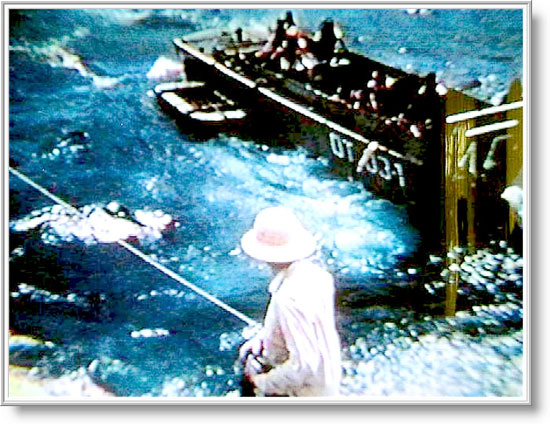
Bob Denniston W0DX was directing the landing operations with the LCVP in the background. Bob wore his pith helmet throughout the expedition. these are shark infested waters. One man aboard the LCVP has an M-2 automatic rifle. Bob is standing about 150 feet from the LCVP and about 40 feet above the ocean level. At the side of the LCVP is a 900 lb. balsa raft. It was this raft that crushed the body of the LCRA president Bill Elazmar when he fell off the island back into the ocean when hit by a large wave.
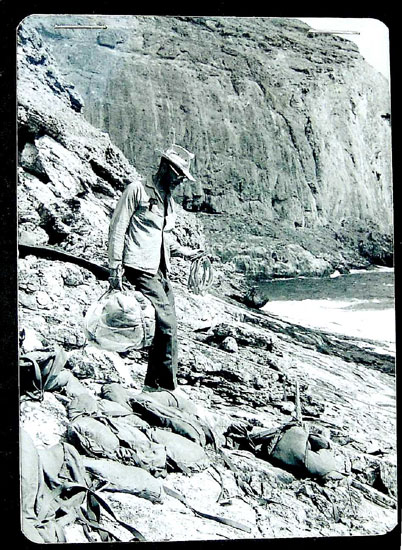
Forty years ago in 1969 there was a small shelf at the edge of the ocean where the landing was possible. It was only 50 to 75 feet wide. The incline was only about 20 to 30 degrees where you see Dale Streiter W4DQS is walking. This small area may now be broken off and washed into the sea. Near Dale's feet are the life vests each person was required to wear during the landing and the egress from the island. With this photo you can appreciate the sheer cliff walls around the entire Island.
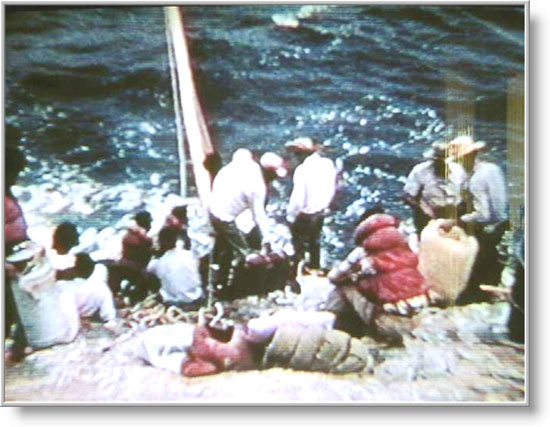
Another view of the embarkation and debarkation point in Feb. 1969.